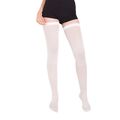Since compression stockings are classified as hygienic products, they are not eligible for returns or exchanges according to legal regulations. Therefore, we cannot accept returns if the product has been tried on or worn.
Please consider this before placing your order. Thank you for your understanding.
Wherever you are in Turkey,
- Free Delivery (Orders of 1000 TL and above)
- Fast Delivery
- Up to 3 business days
- Mobile Distribution areas: 5 business days
For THY Staff and First-Time Customers
- 15% discount for THY staff
- Sign up and get an additional 5% discount
- Earn reward points on orders. More details
Pay the Way You Prefer
- Bank Transfer/EFT
- Credit Card
Credit card payments can be made in 9 installments.
Description
Varimed® Anti-Embolism Stockings: Designed for Patient Comfort and Maximum Benefit
Varimed® Anti-Embolism Stockings are engineered to provide maximum comfort and benefit for patients, meeting the "TS ENV 12719 Medical Thrombosis Prophylaxis Stocking" standard. Available in knee-high, thigh-high, and waist-high styles, the stockings feature a wide range of sizes to accommodate various body types. Each size has a different color at the heel for easy identification. The stockings also have a control hole under the toe to monitor blood circulation. The thigh-high version includes a drop-silicone elastic band that prevents the stocking from slipping down the leg and maintains the pressure profile. The waist-high version features a transparent, soft, and flexible inner elastic band that does not irritate the leg and an adjustable elastic waistband for a comfortable fit.
Varimed® Anti-Embolism Stockings are made with Oeko-Tex 100 certified materials to minimize the risk of allergic reactions. The pressure in the stockings is highest at the ankle and gradually decreases towards the thigh, creating a graduated pressure profile.
Indications for Use:
- Protects against deep vein thrombosis in immobile patients.
- Increases blood flow velocity by providing graduated compression.
- Improves blood flow in other venous disorders such as chronic venous stasis.
Contraindications:
-
Regional leg conditions that may be aggravated by the stocking:
- Cellulitis
- Dermatitis
- Gangrene
- Fasciitis
- Recent skin grafting
- Paniculitis
-
Severe arterial sclerosis or other ischemic vascular disease
-
Severe edema in the legs or pulmonary edema due to congestive heart failure
-
Extreme deformity of the leg
Compression Therapy in the Prevention of Deep Vein Thrombosis
Deep vein thrombosis (DVT) is the formation of a blood clot in a deep vein.
A blood clot in a blood vessel is called a thrombosis. Although thrombosis can occur in both superficial and deep leg veins, thrombosis in deep veins is the most dangerous. The reason it is dangerous is that the entire thrombus or a broken part of it can mix with the blood stream and block the artery going to the lung and prevent blood flow. A moving thrombus is called an embolus. Deep vein thrombosis should not be confused with phlebitis of varicose veins. Phlebitis is painful but relatively harmless.
Three factors can cause deep vein thrombosis:
- First, damage to the vessel wall
- Second, an increased tendency of the blood to clot, which can be caused by some cancers and, rarely, by the use of oral contraceptives.
- Third, slowing of blood flow in the vein. This can be seen in prolonged bed rest because the calf muscles will not contract and will not be able to provide blood flow to the heart. For example, it can occur in patients who have been in the hospital for days after a heart attack and are able to do very little leg exercise, or in paraplegic patients who have to sit for long periods of time and whose muscles are not functioning. Trauma or major surgery can also increase the tendency to clot. It can also be seen in healthy individuals who are forced to be immobile, such as those taking long car or plane trips.
About half of people with deep vein thrombosis have no symptoms at all. In these people, the first symptom may be lung disease due to a pulmonary embolism. When deep vein thrombosis causes inflammation and obstruction of blood flow, the calf may swell and become painful, and may be tender and warm to the touch. The ankle, foot, and thigh may also swell, depending on the vein involved.
As some thrombi heal, they are converted into scar tissue, which can damage the valves in the veins. This can lead to swelling in the ankle due to fluid accumulation. Depending on the size of the affected vein, the blockage can extend significantly upwards and the edema can spread to the leg and thigh. The edema worsens towards the end of the day due to the effects of gravity, depending on whether you are sitting or standing. During the night, the veins are easily emptied as the legs are in a horizontal position and the edema decreases. Although the risk of deep vein thrombosis cannot be completely eliminated, it can be reduced by some means.
One of these ways is to wear anti-embolism stockings. Anti-embolism stockings apply continuous pressure to the legs, which speeds up blood flow and reduces clotting. Anti-embolism stockings apply the highest external pressure at the ankle and decreasing pressure towards the calf and thigh. This increases blood flow in the deep venous system.
Size Chart
| Çevresi (cm) | XSmall | Small | Medium | Large | XLarge | XXLarge | |
|---|---|---|---|---|---|---|---|
| cG | 47 - 56 | 52 - 61 | 56 - 65 | 61 - 71 | 66 - 76 | 60 - 68 | |
| cC | 29 - 36 | 33 - 40 | 35 - 42 | 38 - 45 | 42 - 49 | 39 - 49 | |
| cB | 18 - 20 | 20 - 23 | 23 - 26 | 26 - 29 | 29 - 32 | 32 - 35 | |
| Referans noktası her zaman ayak bileğidir (cB). Ölçüm yapmaya ayak bileğinden başlayınız. Beden tablosunda ilk önce (cB) bölgesini dikkate alınız. | |||||||
| Uzunluk (cm) | Kısa | Normal |
|---|---|---|
| lG (Külotlu, Diz Üstü) | 65 - 74 | 75 - 84 |
| Yerden kasığa kadar olan bölgenin uzunluğunu ölçünüz. Ölçüyü bacağın iç kısmından almanız işlemi kolaylaştıracaktır. | ||
Features
How to Take Measurements
Reviews
No reviews yet





 Login with Google
Login with Google




